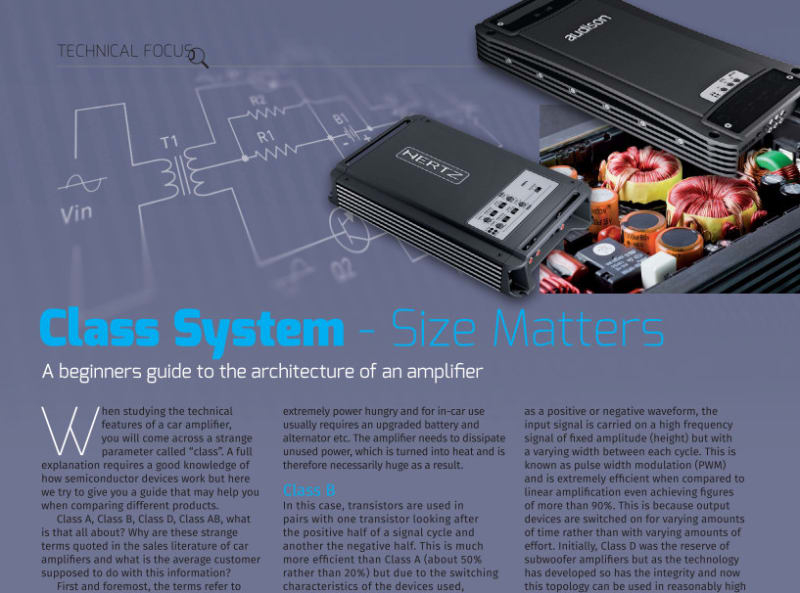
Technical Focus
Class System - Size Matters
When studying the technical features of a car amplifier, you will come across a strange parameter called “class”. A full explanation requires a good knowledge of how semiconductor devices work but here we try to give you a guide that may help you when comparing different products.
Class A, Class B, Class D, Class AB, what is that all about? Why are these strange terms quoted in the sales literature of car amplifiers and what is the average customer supposed to do with this information?
First and foremost, the terms refer to the electronic architecture, also known as topography, of an amplifier. They describe how the components inside are configured or put together and nothing more for the layperson. However, a basic knowledge of performance expectation is always handy in order to help you compare products so we will take each of the above in turn and try to explain the pros and cons.
Class A – Many of the world’s best performing amplifiers use a Class A architecture. Inside an amplifier, the components that do the most work are the output transistors. This is like a solid-state (no moving parts) switch that turns off and on to differing degrees. You can imagine this to be like a tap which can be opened a little bit to give you a small trickle of water or a lot ensuring that you get a wet shirt (especially if there is a misplaced spoon in the sink!). An audio signal has equal positive and negative half cycles both of which need to be amplified equally to maintain the integrity of the signal. With a Class A architecture, the output transistors are kept turned on all of the time. This ensures that both positive and negative parts of the signal are amplified by the same devices avoiding any anomalies being introduced due to the switching action of a circuit featuring an array of transistors.
So, why are not all amplifiers class A. By having the output transistors turned on constantly, current is taken from the power supply at all times even when there is no input signal. This makes this architecture extremely power hungry and for in-car use usually requires an upgraded battery and alternator etc. The amplifier needs to dissipate unused power, which is turned into heat and is therefore necessarily huge as a result.
Class B – In this case, transistors are used in pairs with one transistor looking after the positive half of a signal cycle and another the negative half. This is much more efficient than Class A (about 50% rather than 20%) but due to the switching characteristics of the devices used, introduces distortion at the point where one transistor switches off and the other switches on. This is known as crossover distortion and can sound quite nasty! Class B amplifiers are rare in car audio these days and tend to be used only in low power and low fidelity applications.
Class AB – This has become the weapon of choice for most sound critical applications. As the name suggests it combines the aforementioned topographies. The output devices are still dedicated to either the positive or negative half of the audio signal but the transistors are kept switched on for more than half the cycle. This minimises crossover distortion while maintaining an acceptable efficiency. This is the most common architecture for car and home hi-fi amplifiers.
Class D – Sometimes referred to as a digital amplifier, this is the new kid on the block. Instead of carrying and amplifying the input signal as a positive or negative waveform, the input signal is carried on a high frequency signal of fixed amplitude (height) but with a varying width between each cycle. This is known as pulse width modulation (PWM) and is extremely efficient when compared to linear amplification even achieving figures of more than 90%. This is because output devices are switched on for varying amounts of time rather than with varying amounts of effort. Initially, Class D was the reserve of subwoofer amplifiers but as the technology has developed so has the integrity and now this topology can be used in reasonably high quality full-range audio amplifiers.
Because of the remarkable efficiency of Class D circuitry, there is less heat generated which means amplifiers of significant amounts of power can be fitted into relatively small, light-weight cases. Class D has caused a mini revolution in terms of the space required in a car for an amplifier. Die-hard audiophiles still prefer linear amplifiers however and although developing quickly, Class D is still not quite up to the standard of an equivalently specified Class AB for full range audio.
There is a place for Class A, AB and D in car audio as demonstrated elegantly in the Audison Voce AV 5.1K, which contains all three. Two 75 Watt RMS pure Class A channels sit alongside two 250 Watt RMS Class AB channels and a single 1000 Watt RMS Class D channel making it one of the most versatile audiophile car amplifiers available today.
Hopefully, this article goes someway to explaining the difference between different amplifier designs. We do however, apologise to those scientists and electronics experts amongst us who may find my necessarily brief descriptions somewhat lacking in detail. The truth is that to most of us, a little knowledge is better than being made to look foolish at the point of purchase but more importantly, could save you being exploited for want of some insight.
A good independent specialist such as a FOUR MASTER will be able to help you further and it is important to stress that there is no substitute for the knowledge gained through hands-on experience.
Find out what our partner, The FOUR MASTER Network, can do to bring Hi-Fi quality to your car. Simply put some brief details into the form below.
Not ready for that yet? You can use the same form to book a demonstration at your home, place of work or with your local FOUR MASTER
